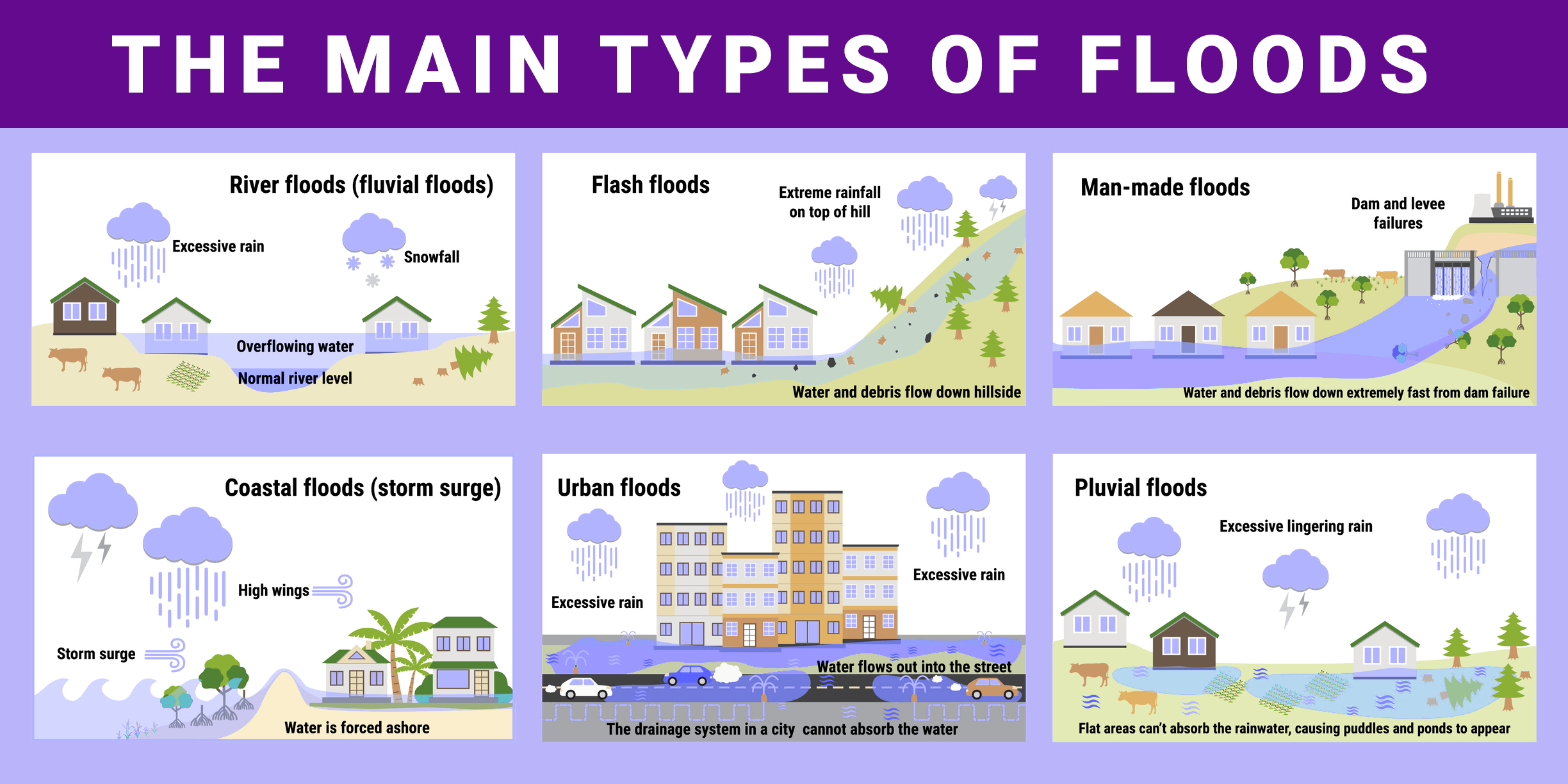Flood Alerts Explained: Types, Sources, And How To Respond

Table of Contents
Types of Flood Alerts
Flood alerts aren't all created equal. Understanding the different levels of severity is paramount to taking appropriate action. These alerts usually fall into three main categories: Watch, Warning, and Advisory. However, the specific terminology and severity levels can vary slightly depending on your location.
-
Flood Watch: A flood watch means that conditions are favorable for flooding. This isn't a cause for immediate panic, but it's a strong indication that flooding is possible in your area within the next few hours or days. Think of it as a yellow alert. For example, heavy rainfall is forecast, and rivers are already near capacity. Be prepared. This is the time to gather your emergency supplies and review your evacuation plan (if you have one).
-
Flood Warning: A flood warning is much more serious. This means that flooding is either happening now or is imminent. This is your red alert. A flood warning indicates that a dangerous situation exists and immediate action is required. For example, a dam has failed, or a river has already overflowed its banks. Take action immediately. Evacuation may be necessary, and you should avoid all flooded areas.
-
Flood Advisory: A flood advisory indicates that flooding is possible but less severe than a warning. It's a less urgent alert than a warning, but it still requires attention. This might be the case when minor flooding is expected in low-lying areas. Be aware of conditions. Monitor the situation closely and avoid areas prone to flooding.
Geographical Variations in Alert Systems
It's crucial to remember that flood alert systems can vary geographically. While the general categories (Watch, Warning, Advisory) are common, the specific terminology and severity levels might differ between national and local authorities. For instance, one region might use "flood potential" instead of "flood watch."
- National Systems: National weather services, like the National Weather Service (NWS) in the United States, provide broad-scale alerts.
- Local Systems: Local emergency management agencies often issue more localized and specific alerts, tailored to the unique geographical characteristics of their area.
Always check your local news and official sources for the most accurate and up-to-date information specific to your region.
| Alert Type | Severity | Action Required |
|---|---|---|
| Flood Watch | Low | Prepare; gather supplies; monitor conditions. |
| Flood Advisory | Moderate | Stay informed; avoid flooded areas; exercise caution. |
| Flood Warning | High | Evacuate if instructed; move valuables; avoid flooded areas. |
Sources of Flood Alerts
Knowing where to get your flood alerts is just as important as understanding what they mean. Multiple sources offer flood alerts, and utilizing several ensures you receive comprehensive coverage.
-
National Weather Service (NWS): The NWS (or your country's equivalent) is a primary source for weather-related alerts, including flood warnings and advisories. Their website and mobile app provide detailed information and forecasts.
-
Local Emergency Management Agencies: Local agencies often have more localized and specific information, providing detailed alerts based on your immediate environment. Check their websites or social media for updates.
-
Mobile Apps: Several mobile apps provide real-time weather alerts and emergency notifications. Popular options include the NOAA Weather app, FEMA, and various commercial weather apps.
-
News Media: Local news channels and websites frequently broadcast and publish flood alerts. They often provide visual updates and on-the-ground reporting.
It's essential to use multiple sources to verify information and ensure you receive a comprehensive understanding of the situation. You can even subscribe to receive alerts via text message or email.
How to Respond to Flood Alerts
Your response to a flood alert will depend entirely on the alert level. Having a plan in place before a flood event occurs is crucial.
Step-by-Step Action Plan
-
Flood Watch:
- Gather your emergency supplies (water, food, first-aid kit, medications, important documents).
- Monitor weather conditions closely.
- Know your evacuation routes.
- Charge electronic devices.
-
Flood Warning:
- Evacuate immediately if instructed by authorities.
- Move valuable items to higher ground.
- Avoid driving through flooded areas; even a small amount of water can sweep a car away.
- Unplug electrical appliances.
-
Flood Advisory:
- Stay informed about the developing situation.
- Avoid driving or walking through flooded areas.
- Be cautious near rivers, streams, and other bodies of water.
Essential Emergency Supplies: Always keep a well-stocked emergency kit ready. This should include at least three days' worth of water, non-perishable food, a first-aid kit, medications, important documents (copies), flashlights, batteries, and a radio.
After a flood, remember to prioritize your safety. Avoid damaged buildings, be cautious of downed power lines, and follow instructions from emergency officials during cleanup and recovery efforts.
Conclusion
This guide provided a comprehensive overview of flood alerts, covering their types, sources, and how to respond effectively. Understanding and acting upon flood alerts is critical for minimizing risk and ensuring personal safety. Knowing the difference between a flood watch and a flood warning can be the difference between being prepared and facing a life-threatening emergency.
Stay informed and prepared! Sign up for flood alerts in your area today, and regularly check reliable sources for updated information on flood warnings and advisories. Don't wait for a flood to strike – prepare for flood alerts now!

Featured Posts
-
 Piazza Affari Oggi Fed Banche E Prospettive
May 25, 2025
Piazza Affari Oggi Fed Banche E Prospettive
May 25, 2025 -
 Zheng Qinwen Stuns Sabalenka Reaches Italian Open Semifinals
May 25, 2025
Zheng Qinwen Stuns Sabalenka Reaches Italian Open Semifinals
May 25, 2025 -
 Amundi Dow Jones Industrial Average Ucits Etf Nav And Its Implications For Investors
May 25, 2025
Amundi Dow Jones Industrial Average Ucits Etf Nav And Its Implications For Investors
May 25, 2025 -
 Significant Drop In Amsterdam Stock Exchange Aex Index Down Over 4
May 25, 2025
Significant Drop In Amsterdam Stock Exchange Aex Index Down Over 4
May 25, 2025 -
 Mynamynw Ybqa Fy Mwnakw Tmdyd Eqd Hta Eam 2024
May 25, 2025
Mynamynw Ybqa Fy Mwnakw Tmdyd Eqd Hta Eam 2024
May 25, 2025
Latest Posts
-
 Naomi Campbells Potential Absence From Met Gala 2025 Truth Behind The Wintour Feud Claims
May 25, 2025
Naomi Campbells Potential Absence From Met Gala 2025 Truth Behind The Wintour Feud Claims
May 25, 2025 -
 Did Anna Wintour Ban Naomi Campbell From The Met Gala The 2025 Controversy
May 25, 2025
Did Anna Wintour Ban Naomi Campbell From The Met Gala The 2025 Controversy
May 25, 2025 -
 Naomi Campbell Reportedly Banned From Met Gala 2025 The Story Behind The Headlines
May 25, 2025
Naomi Campbell Reportedly Banned From Met Gala 2025 The Story Behind The Headlines
May 25, 2025 -
 Is Naomi Campbell Banned From The 2025 Met Gala A Look At The Wintour Feud Speculation
May 25, 2025
Is Naomi Campbell Banned From The 2025 Met Gala A Look At The Wintour Feud Speculation
May 25, 2025 -
 Met Gala 2025 Will Naomi Campbell Be Absent Due To Wintour Dispute
May 25, 2025
Met Gala 2025 Will Naomi Campbell Be Absent Due To Wintour Dispute
May 25, 2025
